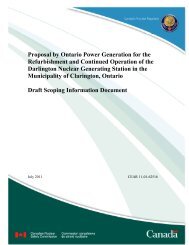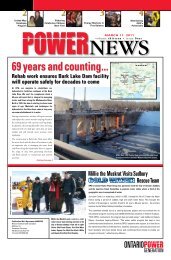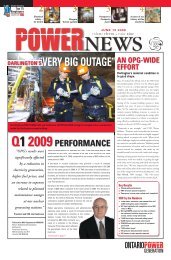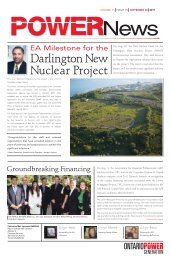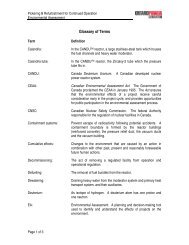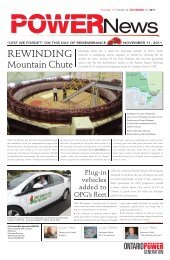Kid's Guide - Ontario Power Generation
Kid's Guide - Ontario Power Generation
Kid's Guide - Ontario Power Generation
Create successful ePaper yourself
Turn your PDF publications into a flip-book with our unique Google optimized e-Paper software.
The<br />
Kid’s <strong>Guide</strong> to<br />
Staying Clear and<br />
Staying Safe<br />
What you need to know about safety<br />
around dams, hydroelectric stations<br />
and surrounding waterways.
The<br />
Kid’s <strong>Guide</strong> to<br />
Staying Clear and<br />
Staying Safe<br />
is brought to you by<br />
<strong>Ontario</strong> <strong>Power</strong> <strong>Generation</strong> (OPG) is a company<br />
that makes electricity. One of the sources<br />
of the energy it makes is a clean and<br />
renewable resource: WATER.<br />
OPG’s dams and hydroelectric stations are located all<br />
across the province. In fact, there are more than 240 dams and 64 hydroelectric<br />
generating stations on 25 river systems in <strong>Ontario</strong> alone. But, OPG is not the<br />
only company that makes electricity. There are many other dams and hydroelectric<br />
stations across the province too!<br />
Although these facilities are an important, renewable energy source, they are NOT<br />
places for recreation. To help ensure you “Stay Clear, Stay Safe!” arm yourself<br />
with the facts! It could mean the difference between life and death!<br />
Areas surrounding OPG’s dams and hydroelectric stations<br />
have signs like these to warn you. Obey the signs and other<br />
safety barriers and always be alert for DANGER.<br />
2
Yikes! In just moments this calm river (shown<br />
on the cover) has turned into rapids! That’s<br />
because the hydroelectric station upstream has<br />
been turned on. Now, even the shoreline is<br />
unsafe for people —and frogs.<br />
3
So you’re out hiking on a hot day and you come<br />
across an unfamiliar lake. You...<br />
a<br />
b<br />
c<br />
Take a flying leap off the cliff and plunge<br />
head-first into the water!<br />
Wade in slowly for a refreshing dip!<br />
Stay Clear and Stay Safe!<br />
If you picked c, you are right. You should never go<br />
swimming, fishing or boating in any unfamiliar lake or river<br />
unless you know it’s a safe recreation zone first.<br />
Dams and hydroelectric stations operate all year round,<br />
24 hours a day. Ice that forms on the surrounding waterways<br />
can be thinner due to the changing currents beneath it.<br />
Which of the<br />
following activities<br />
should be avoided<br />
near dams and<br />
hydroelectric stations<br />
in the winter?<br />
a<br />
b<br />
c<br />
d<br />
e<br />
snowmobiling<br />
cross-country skiing<br />
skating<br />
ice fishing<br />
all of the above<br />
If you picked e, you are right! Don’t even risk walking onto a<br />
river or lake where the ice may be thin due to the changing currents.<br />
Stay Clear and Stay Safe all Year Round!<br />
Illustration: Tim Murray<br />
4
How Hydroelectric<br />
Stations Work:<br />
1<br />
2<br />
3<br />
4<br />
1 Water is stored in the headpond above<br />
the dam and hydroelectric station.<br />
3 The water surges through the pipes creating<br />
a torrent of waves and undercurrents.<br />
2 The dam opens up and the water is<br />
suddenly released through hidden pipes.<br />
4 The flow of water pushes up against<br />
giant turbines, which spin generators to<br />
create power.<br />
5
Smooth Operators!<br />
Throughout the day and night, the<br />
demand for electricity rises and<br />
falls. Dam operators, sometimes stationed<br />
far away, open and close the dams<br />
as needed and often by remote<br />
control. This means the water levels can<br />
change frequently and FAST—they can<br />
turn from calm waters into deadly<br />
rapids in a moment’s notice!<br />
Let’s see, dams and hydroelectric<br />
stations help make electricity.<br />
And YOU need electricity to<br />
power things like your microwave,<br />
your TV set, your refrigerator<br />
and so on. Can you imagine life without<br />
your computer or DVD player?<br />
Didn’t think so!<br />
If you’re thinking:<br />
“So what’s the big deal? There are<br />
no dams where I live.”<br />
You are wrong!<br />
With 64 hydroelectric stations in<br />
<strong>Ontario</strong> alone, these facilities are<br />
all around. No matter where you<br />
live or vacation, there’s bound to be<br />
one nearby. Use this map to help<br />
you spot the many stations in your area.<br />
Did you even know<br />
they were there?<br />
LEGEND:<br />
64 Hydroelectric<br />
Stations<br />
6
What happens if you DO end up at a dam<br />
or hydroelectric station?<br />
OPG facilities are marked by RED, WHITE and YELLOW danger signs.<br />
There are also fences, buoys, booms and barriers telling you to keep out!<br />
But if you do end up in the vicinity of a dam, here is what to do:<br />
o<br />
o<br />
o<br />
Stay a safe distance outside of warning signs, buoys, and barriers<br />
when fishing, boating, or swimming.<br />
Stay well back from the edge of waters above and below<br />
hydroelectric stations.<br />
Stay off all dams and hydroelectric station structures unless walkways<br />
or observation points have been clearly indicated.<br />
o<br />
Stay well back of dry riverbeds below dams. They can quickly change<br />
into rapidly flowing waterways. Be alert for changes in water levels.<br />
Illustration: Tim Murray<br />
o<br />
o<br />
o<br />
When swimming, fishing, or boating, be aware of the water level and check<br />
upstream frequently for any sign of increasing currents. If the water level is rising<br />
or the flow is speeding up, get out of the water.<br />
Stay well back from the edge of a waterway where footing may be slippery.<br />
Set an example for kids who may not be aware of the dangers. If someone<br />
suggests going into water that could be unsafe, take charge and warn them<br />
to stay away!<br />
7
Be a water wiz!<br />
Use your new knowledge to<br />
solve this water safety puzzle.<br />
2.<br />
5.<br />
7. 9.<br />
1.<br />
8.<br />
ACROSS:<br />
1. You should never ___ or boat in unfamiliar water.<br />
2. <strong>Ontario</strong> <strong>Power</strong> <strong>Generation</strong> is a company<br />
that makes ___.<br />
3. If you are near a dam, there will be signs that say ___.<br />
4. “Stay Clear! Stay ___ !”<br />
3.<br />
4.<br />
6.<br />
DOWN:<br />
5. A hydro reservoir looks a lot like a typical ___ or river.<br />
6. ___ are sometimes operated by remote control.<br />
7. This word means the movement or flow of water.<br />
(When a dam has been opened it increases.)<br />
8. In the wintertime, the ___ can be thin, so never walk,<br />
ski or snowmobile near dams.<br />
9. ___ is a clean, renewable resource!<br />
Answers: 1. swim, 2. electricity, 3. danger, 4. safe,<br />
5. lake, 6. dams, 7. current, 8. ice, 9. water<br />
Remember, dams and hydroelectric stations,<br />
and the areas around them are NOT:<br />
o<br />
o<br />
o<br />
o<br />
o<br />
o<br />
o<br />
parks<br />
fishing holes<br />
boating areas<br />
swimming areas<br />
camping sites or picnic areas<br />
snowmobile or cross-country ski areas<br />
safe places for recreation<br />
8<br />
Visit www.opg.com for more safety information or<br />
to order a free safety DVD or interactive CD-ROM!<br />
This booklet was created by Paton Publishing www.patonpublishing.com<br />
Illustration: Tim Murray



